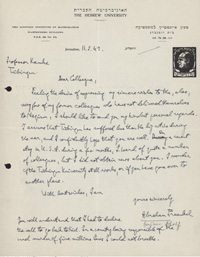
- Letter from Abraham Fraenkel to Erich Kamke, 11 February 1947. In the letter, Fraenkel explained his decision not to return to his former chair in Kiel: “In a country being responsible of the cruel murder of five million Jews I could not breathe.”
12 Return?
For a variety of reasons, very few Jewish mathematicians who had emigrated returned to Germany after 1945. Eventually only three mathematicians returned to a German university: in 1956 Reinhold Baer accepted a professorship in Frankfurt, where he then had many prominent doctoral students; Hans Hamburger returned to Cologne in 1953, where he had taught to 1935; and Friedrich Wilhelm Levi came to Berlin in 1952 and retired in 1956.
In post-war Germany, the Nazi past and especially the Holocaust were topics that were rarely addressed. This silence stood between Germans and Jewish emigrants, many of whom could not envisage returning to Germany or even reestablishing connections in the face of the ignorant or indifferent stance of most German colleagues.
The German mathematician Maximilian (Max) Pinl was the first to state clearly how many mathematicians had been forced out of their positions with deceptive labels such as “withdrawal of the venia legendi,” “removal from office,” or “retirement”. When he wanted to publish his results in the annual report of the German Mathematical Society in the mid-1960s, he still had to face the opposition of the society’s board. In 1973 Pinl and Lux Furtmüller published a summary report in the Leo Baeck Institute Yearbook that provided the first overview of the various stations of exile and the range of career paths taken by 127 mathematicians (including five women) driven out of Germany after 1933.